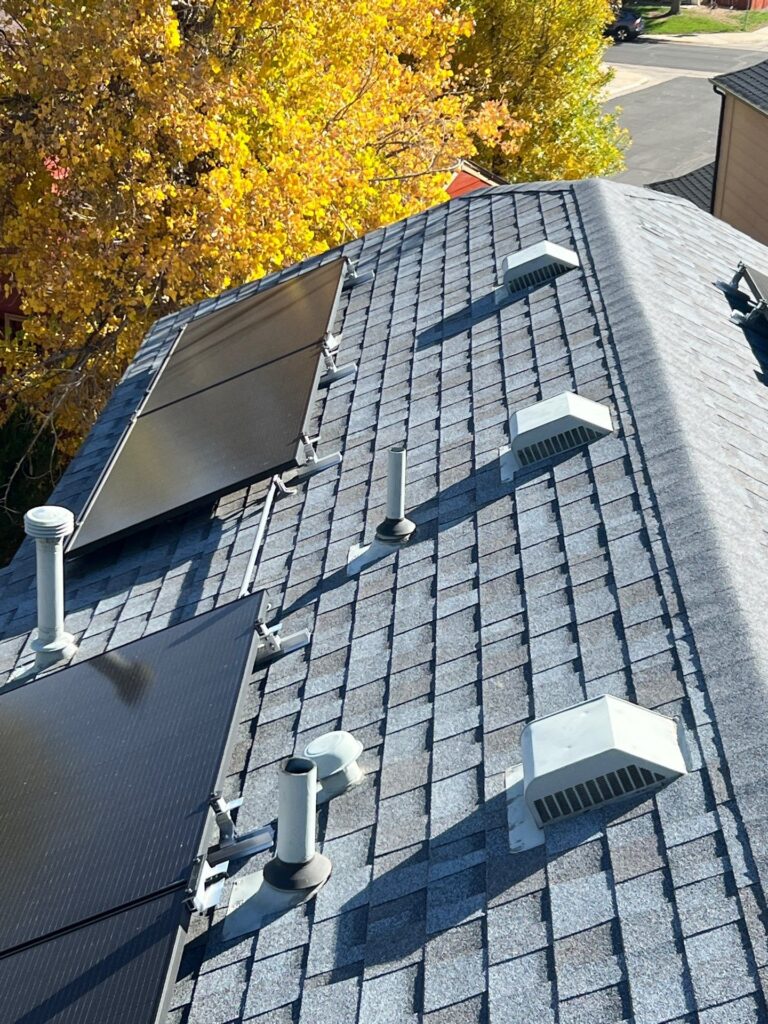Colorado’s climate presents unique challenges that significantly impact the lifespan of roofs. The combination of extreme temperature fluctuations, intense UV radiation, heavy snowfall, and frequent hailstorms accelerates wear and tear on roofing materials. Homeowners must consider these environmental factors when selecting materials, planning installations, and maintaining their roofs.
The Impact of Colorado’s Climate on Roof Durability
Extreme Temperature Fluctuations
Colorado experiences drastic temperature swings, sometimes within a single day. These sudden temperature fluctuations cause roofing materials to expand and contract, eventually resulting in cracks, warping, and structural deterioration. Asphalt shingles, for example, may become brittle due to repeated freezing and thawing cycles, while metal roofing systems may require additional fasteners to accommodate expansion.
High-Altitude UV Exposure
At Colorado’s high elevation, UV exposure is more intense than in lower-altitude regions. Prolonged sun exposure weakens roofing materials, causing fading, brittleness, and premature deterioration. Roofs with reflective coatings or UV-resistant materials tend to last longer in this environment.
Heavy Snow and Ice Accumulation
Winters in Colorado bring substantial snowfall, placing excessive weight on roofs. Accumulated snow can lead to ice dam formation, which blocks proper drainage and increases the risk of leaks. Proper insulation and ventilation help prevent these issues by regulating roof temperature and reducing ice buildup.
Intense Hailstorms
Colorado ranks among the most hail-affected states in the nation. Hailstones can cause immediate damage to roofing materials, puncturing shingles, denting metal panels, and cracking tiles. Investing in impact-resistant roofing materials can mitigate damage and extend roof lifespan.
Strong Winds and Chinook Effects
High winds, especially in areas susceptible to Chinook winds, can lift shingles or loosen roofing materials. Proper installation techniques, including secure fastenings and wind-resistant shingles, help prevent wind damage.
Choosing the Best Roofing Materials for Colorado Homes
The choice of roofing material plays a crucial role in determining the lifespan of a roof. Some materials perform better than others in Colorado’s harsh climate.
Asphalt Shingles
Known for their affordability and easy installation, asphalt shingles remain a popular roofing option. However, traditional asphalt shingles tend to have a shorter lifespan in Colorado due to extreme temperature changes and prolonged UV exposure. Opting for impact-resistant shingles with higher durability ratings can improve longevity.
Metal Roofing
Metal roofing is highly durable and resistant to snow, wind, and UV damage. It expands and contracts with temperature changes, but proper installation accounts for this movement. Metal roofs also shed snow easily, reducing structural strain during winter.
Tile Roofing
Clay and concrete tiles are highly durable, with lifespans exceeding 50 years. They withstand temperature extremes well but are susceptible to hail damage. Reinforced tiles offer better impact resistance.
Slate Roofing
Slate is one of the longest-lasting roofing materials, with some roofs lasting over a century. It is highly resistant to fire, hail, and UV damage but requires strong structural support due to its weight.
Advanced Synthetic Roofing
Constructed from rubber or polymer composites, synthetic shingles replicate the look of natural materials while providing superior durability. Many synthetic roofing products are impact-resistant and UV-stable, making them an excellent choice for Colorado homes.
The Importance of Professional Roof Installation
Proper installation is critical to maximizing the lifespan of a roof in Colorado. Even high-quality materials will fail prematurely if installed incorrectly.
Ensuring a Secure Installation
Certified roofing professionals understand the unique climate challenges in Colorado and employ techniques to enhance durability. This includes using high-quality fasteners, reinforcing seams, and installing proper flashing to prevent leaks.
Proper Ventilation and Insulation
A well-ventilated attic regulates temperature and moisture levels, preventing mold growth, ice dams, and premature shingle deterioration. Insulation reduces heat transfer, improving energy efficiency while protecting the roofing system.
Flashing and Waterproofing
Flashing around chimneys, skylights, and roof valleys prevents water intrusion. Poorly installed flashing can lead to leaks and structural damage, underscoring the importance of professional craftsmanship.
Regular Roof Maintenance for Longevity
Routine maintenance extends roof lifespan by addressing minor issues before they escalate into major problems.
Biannual Roof Inspections
A professional inspection in the spring and fall identifies early signs of wear, such as cracked shingles, rusting metal, or missing fasteners. Catching these problems early prevents costly repairs.
Gutter Cleaning and Drainage Management
Clogged gutters lead to water backup, increasing the risk of leaks and ice dam formation. Keeping gutters clean on a regular basis ensures efficient water drainage and helps prevent potential damage.
Addressing Hail and Wind Damage
After a severe storm, homeowners should assess their roofs for damage. Even small punctures or cracks can lead to long-term structural problems. Impact-resistant materials and storm-resistant design choices help mitigate damage risks.
Preventing Ice Dams
Installing heated cables along roof edges, ensuring adequate insulation, and maintaining proper attic ventilation minimize the formation of ice dams during winter.
When to Replace a Roof in Colorado
Despite regular maintenance, all roofs eventually require replacement. Signs that indicate a roof needs replacement include:
- Frequent Repairs – If repairs become more frequent and costly, replacing the roof may be more economical.
- Widespread Shingle Damage – Curling, missing, or cracked shingles suggest the roof has reached the end of its lifespan.
- Water Leaks and Mold Growth – Persistent leaks and moisture buildup indicate failing waterproofing.
- Sagging or Structural Weakness – Roofs showing signs of sagging or compromised structural integrity require immediate attention.
When considering a roof replacement, homeowners should consult experienced roofers in Denver who specialize in Colorado’s climate challenges. Companies like Tried and True Roofing , a leading roofing company in Denver , provide expert installation, ensuring durability and long-term protection.
Conclusion
Colorado’s harsh weather conditions demand careful planning when selecting, installing, and maintaining a roof. From intense UV exposure and hailstorms to heavy snowfall and temperature swings, numerous factors affect roof longevity. By choosing high-quality materials, investing in professional installation, and performing regular maintenance, homeowners can maximize their roof’s lifespan and protect their property from costly damage. Consulting with Denver roofers ensures homeowners receive expert guidance tailored to their unique needs.
